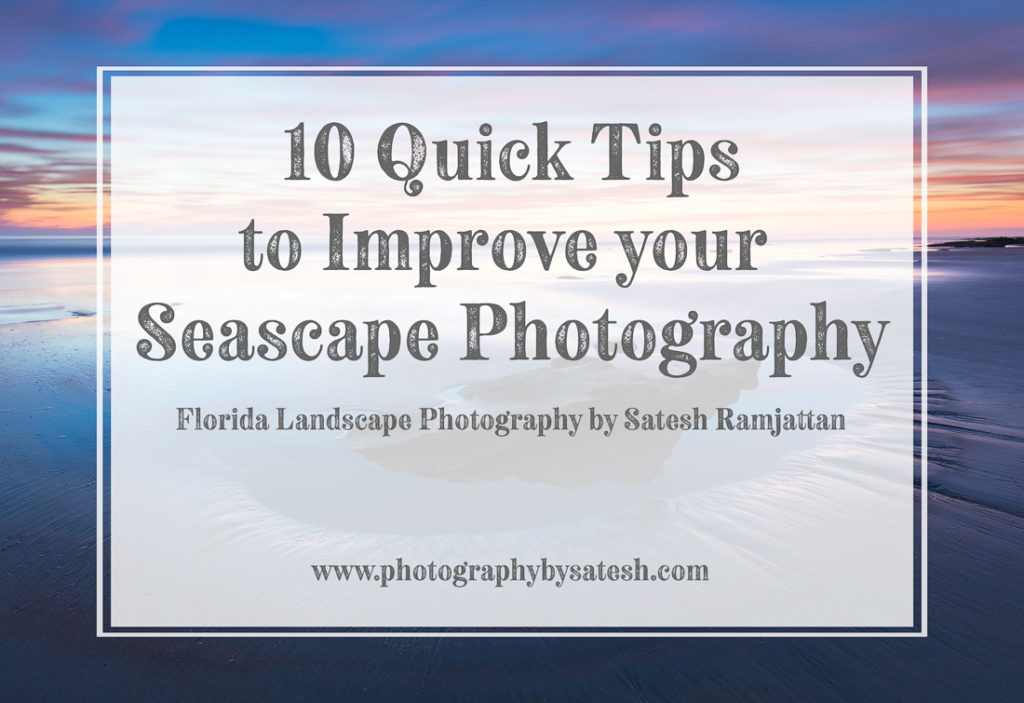Happy New Year! With the holiday season now over, I want to give you all a little gift. So I decided to share some quick tips for shooting seascapes. I’m sure some of you may have upgraded or purchased your first DSLR and are anxious to get out and shoot. I hope these tips come in handy for you.
10 Tips for Shooting Seascapes
1. Scout your location. Visiting a new location the day before will really help you get a feel of what to expect when you come back the next day, especially if you plan to shoot at sunrise. Most beaches are pretty dark before the sun comes up so scouting around the day before will ensure you won’t struggle to find a composition.
2. Check the tides. When planning a seascape shoot, knowing the tide can help you determine what sort of photograph you will come away with. For example, low tides are great for photographing textures and tide pools left behind by the ocean. On the other hand, high tides are perfect for capturing waves crashing against the shore or rocks like the Anastasia formations along Florida’s east coast. So if you are looking for a very calm and tranquil photo, I recommend low tide. But, if you want action and movement then high tide will give you better results.
3. Look for an interesting foreground. It’s important to include a strong foreground interest in your photograph. Not only does it make the shot more compelling, but it also adds depth to the scene. If you can’t find a strong foreground, use the waves crashing ashore or receding back. Play with slower shutter speeds to get different effects and textures, as well as leading lines.
4. Use a slow shutter speed. By using a shutter speed of 1/4thsecond or slower, you can capture some really nice movement of the waves. But, once you get into shutter speeds around 10 seconds or more then the water becomes flat and it gives you that smooth silky look.
5. Make sure your tripod is stable. When shooting near the shoreline, make sure your tripod is firmly pressed into the sand to ensure it won’t move or sink. This is very important especially when shooting long exposures because any kind of movement will ruin your shot.
6. Watch out for waves. This tip is a bit of a follow up from the one above since you will be shooting close to the shoreline. It’s very easy to get distracted while framing compositions or fine-tuning focus, but it’s important to be aware of the waves coming toward you. One rogue wave can be disastrous not only to your camera but to you as well. Practice peeking up for waves often, especially if the conditions are rough.
7. Pack lens cleaners. Always pack lens cleaners. Yes, I wrote it twice so you don’t forget them. Pack each of the following: lens wipes, microfiber cloths and an air blower. It is inevitable that sea spray will get on the front of your lens. In addition to peeking for waves, make it a practice to inspect the front of your lens for sea spray or droplets. Your shot may look good on the back of your camera, but you will definitely see the sea spray on your monitor at home.
8. Clean your gear thoroughly after. Salt water loves to eat away at your gear. Make it another practice to clean your gear from salt water and sand ASAP. Learn to take your tripod apart to clean every nook and cranny. This helps to avoid salt and sand build up, which causes that dreaded scraping sound when you twist and extend the legs.
9. Get wet… Even if it’s just your feet. The way I see it, if you didn’t get wet while shooting then you didn’t have fun. Trust me. It is so rewarding to walk away just a little bit wet. I describe it as exhilarating and refreshing. Even more so if your sleepy from waking up at 4AM to catch the sunrise.
10. Have fun and experiment. Visit the same location during each tide. You will be surprised how different the location will look. Also, visit the same location a few times throughout the year. Seascapes are always changing, especially after tidal erosion, storm surge and hurricanes. These events can take away as well as add/uncover elements that alter the scene.
If you want more FREE tips, don’t forget to subscribe. Also, if you want to improve your photography, I offer one on one workshops where we practice out in the field in real world situations. Post processing classes are also available. Mention this blog post and I will take 20% off.
